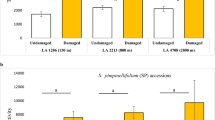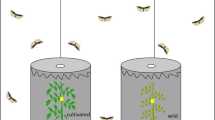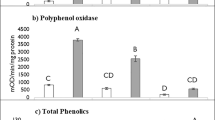Abstract
Among other functions, trichomes defend plants against herbivores. Based on resource allocation theory, we hypothesized that foliar trichome density is determined by the balance between the fitness benefits and costs of trichome production, including possible resource allocation trade-offs with other functions, all of which may change with ontogeny and reproductive phenology. To assess the benefits and possible allocation trade-offs of trichome production, we examined the degree to which trichomes confer resistance against herbivores, and tested whether trichome density and resistance change with leaf ontogeny and with fruit production. Using six tomato varieties, we determined trichome density and tested for constitutive resistance of unexpanded and expanded leaves sampled from plants at their vegetative and reproductive stages by means of choice bioassays with a generalist caterpillar. We found a positive association between trichome density and resistance, albeit the relation was saturating rather than simple linear. Unexpanded leaves had greater trichome density and resistance than expanded leaves in vegetative plants. No such ontogenetic pattern was seen in reproductive plants. Trichome density of expanded leaves of reproductive plants did not differ significantly from that of unexpanded leaves of either vegetative or reproductive plants. Lastly, varieties with greater seed production had lower resistance. Such a clear trade-off suggests a high cost of resistance, which may have important implications for crop improvement programs.



Similar content being viewed by others
References
Avery PB, Kumar V, Simmonds MS, Faull J (2015) Influence of leaf trichome type and density on the host plant selection by the greenhouse whitefly, Trialeurodes vaporariorum (Hemiptera: Aleyrodidae). Appl Entomol Zool 50:79–87
Bergau N, Bennewitz S, Syrowatka F, Hause G, Tissier A (2015) The development of type VI glandular trichomes in the cultivated tomato Solanum lycopersicum and a related wild species S. habrochaites. BMC Plant Biol 15:289
Björkman C, Dalin P, Ahrné K (2008) Leaf trichome responses to herbivory in willows: induction, relaxation and costs. New Phytol 179:176–184
Chang J et al (2016) Fine mapping of the dialytic gene that controls multicellular trichome formation and stamen development in tomato. Theor Appl Genet 129:1531–1539
Coley PD, Kursar TA, Mulkey SS, Chazdon RL, Smith AP (1996) Anti-herbivore defenses of young tropical leaves: physiological constraints and ecological trade-offs. In: Tropical forest plant ecophysiology. Chapman & Hall, New York, pp 305–336
de Jong TJ, Klinkhamer PGL (2005) Evolutionary ecology of plant reproductive strategies. Cambridge University Press, Cambridge
Degenhardt J, Gershenzon J, Baldwin IT, Kessler A (2003) Attracting friends to feast on foes: engineering terpene emission to make crop plants more attractive to herbivore enemies. Curr Opin Biotechnol 14:169–176. https://doi.org/10.1016/S0958-1669(03)00025-9
FAOSTAT (2018) http://www.fao.org/faostat/en/#data/QC. Accessed 27 June 2018
Glas JJ, Schimmel BC, Alba JM, Escobar-Bravo R, Schuurink RC, Kant MR (2012) Plant glandular trichomes as targets for breeding or engineering of resistance to herbivores. Int J Mol Sci 13:17077–17103
Handley R, Ekbom B, Ågren J (2005) Variation in trichome density and resistance against a specialist insect herbivore in natural populations of Arabidopsis thaliana. Ecol Entomol 30:284–292
Harper JL (1989) The value of a leaf. Oecologia 80:53–58
Hoque S, Avila-Sakar G (2015) Trade-offs and ontogenetic changes in resistance and tolerance to insect herbivory in Arabidopsis. Int J Plant Sci 176:150–158
Karban R, Baldwin IT (1997) Induced responses to herbivory. The University of Chicago Press, Chicago
Kariyat RR, Smith JD, Stephenson AG, De Moraes CM, Mescher MC (2017) Non-glandular trichomes of Solanum carolinense deter feeding by Manduca sexta caterpillars and cause damage to the gut peritrophic matrix. Proc R Soc Lond B 284:20162323
Kennedy GG (2003) Tomato, pests, parasitoids, and predators: tritrophic interactions involving the genus Lycopersicon. Annu Rev Entomol 48:51–72
Koelewijn HP (2004) Rapid change in relative growth rate between the vegetative and reproductive stage of the life cycle in Plantago coronopus. New Phytol 163:67–76
Kornelsen J, Avila-Sakar G (2015) Ontogenetic changes in defence against a generalist herbivore in Arabidopsis thaliana. Plant Ecol 216:847–857
Levin DA (1973) The role of trichomes in plant defense. Q Rev Biol 48:3–15
Li X, Garvey M, Kaplan I, Li B, Carrillo J (2018) Domestication of tomato has reduced the attraction of herbivore natural enemies to pest-damaged plants. Agric For Entomol 20:390–401. https://doi.org/10.1111/afe.12271
McDowell ET et al (2011) Comparative functional genomic analysis of Solanum glandular trichome types. Plant Physiol 155:524–539. https://doi.org/10.1104/pp.110.167114
McKey D, Rosenthal GA, Janzen DH (1979) The distribution of secondary compounds within plants. In: Herbivores: their interaction with secondary plant metabolites. Academic Press, New York, pp 55–133
Milla R, Osborne CP, Turcotte MM, Violle C (2015) Plant domestication through an ecological lens. Trends Ecol Evol 30:463–469
Neter J, Wasserman W, Kutner MH (1990) Applied linear statistical models: regression, analysis of variance, and experimental designs, 3rd edn. Irwin, Boston
Oney MA, Bingham RA (2014) Effects of simulated and natural herbivory on tomato (Solanum lycopersicum var. esculentum) leaf trichomes. Bios 85:192–198
Owen MD, Beckie HJ, Leeson JY, Norsworthy JK, Steckel LE (2015) Integrated pest management and weed management in the United States and Canada. Pest Manag Sci 71:357–376
Picanço M, Bacci L, Crespo A, Miranda M, Martins JC (2007) Effect of integrated pest management practices on tomato production and conservation of natural enemies. Agric For Entomol 9:327–335
Roy B, Stanton M, Eppley S (1999) Effects of environmental stress on leaf hair density and consequences for selection. J Evol Biol 12:1089–1103
Simmons AT, Gurr GM (2005) Trichomes of Lycopersicon species and their hybrids: effects on pests and natural enemies. Agric For Entomol 7:265–276
Sletvold N, Huttunen P, Handley R, Kärkkäinen K, Ågren J (2010) Cost of trichome production and resistance to a specialist insect herbivore in Arabidopsis lyrata. Evol Ecol 24:1307–1319
Stamp N (2003) Out of the quagmire of plant defense hypotheses. Q Rev Biol 78:23–55
Tian D, Tooker J, Peiffer M, Chung SH, Felton GW (2012) Role of trichomes in defense against herbivores: comparison of herbivore response to woolly and hairless trichome mutants in tomato (Solanum lycopersicum). Planta 236:1053–1066
Traw MB, Feeny P (2008) Glucosinolates and trichomes track tissue value in two sympatric mustards. Ecology 89:763–772. https://doi.org/10.1890/07-0729.1
Werker E (2000) Trichome diversity and development. Adv Bot Res 31:1–35
Wilkens RT, Shea GO, Halbereich S, Stamp NE (1996) Resource availability and the trichome defenses of tomato plants. Oecologia 106:181–191
Yang C, Ye Z (2013) Trichomes as models for studying plant cell differentiation. Cell Mol Life Sci 70:1937–1948
Acknowledgements
Thanks to Sreedevi Ramachandran and Mark Rondeau for their help with plant care and to Ian Russell for helping with the larvae cultures and data collection. This work was supported in part by the University of Winnipeg through an internal grant to GAS, and by a crowdfunding project from the University of Winnipeg Foundation. Thanks to two anonymous reviewers for their constructive comments, which helped us improve this paper.
Author information
Authors and Affiliations
Corresponding author
Additional information
Handling Editor: Joe Louis.
Publisher’s Note
Springer Nature remains neutral with regard to jurisdictional claims in published maps and institutional affiliations.
Electronic supplementary material
Below is the link to the electronic supplementary material.
Rights and permissions
About this article
Cite this article
Mymko, D., Avila-Sakar, G. The influence of leaf ontogenetic stage and plant reproductive phenology on trichome density and constitutive resistance in six tomato varieties. Arthropod-Plant Interactions 13, 797–803 (2019). https://doi.org/10.1007/s11829-019-09690-3
Received:
Accepted:
Published:
Issue Date:
DOI: https://doi.org/10.1007/s11829-019-09690-3




